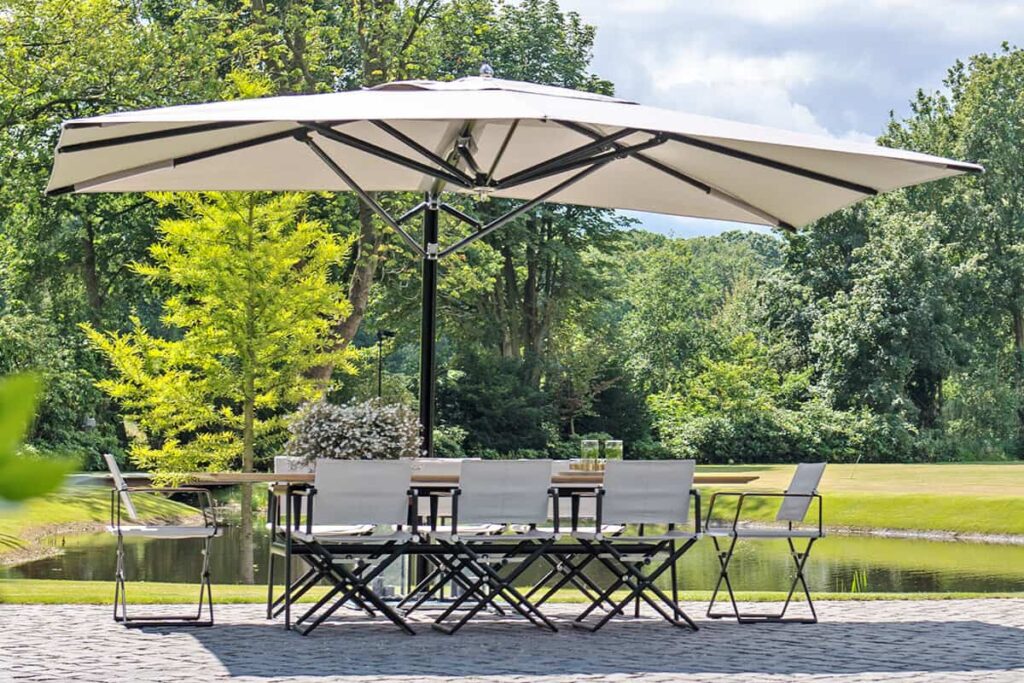What are Patio Umbrellas?
Patio umbrellas are a simple yet effective way to enhance your outdoor space and protect yourself from the elements. Whether you are enjoying a hot summer day or a cool autumn evening, patio umbrellas can provide much-needed shade and shelter for outdoor activities.
These versatile umbrellas come in a variety of sizes, shapes, and styles, so you can find the perfect option to suit your needs. From classic market umbrellas to modern cantilever styles, there is a wide range of umbrella types to choose from.
Patio umbrellas typically consist of several key components: a frame, a canopy, and a base. The frame can be made from a range of materials, including aluminum, wood, and fiberglass, and can feature a crank mechanism for easy opening and closing. The canopy fabric is available in many different colors and materials, such as acrylic, polyester, and Olefin, and can provide additional protection from wind and inclement weather.
When selecting a patio umbrella, it’s important to consider the size of the umbrella canopy, as well as the diameter of the pole. You’ll want to ensure that your umbrella is wide enough to provide ample shade and shelter for your outdoor dining table or patio furniture. Additionally, the pole diameter should be appropriate for the size and weight of your umbrella, as well as sturdy enough to withstand strong winds and gusts.
Patio umbrellas offer an affordable and practical option for enhancing your outdoor space and protecting yourself from the elements. Whether you prefer the classic look of a wooden frame or the modern appeal of an aluminum umbrella, there is a wide range of patio umbrella types, color and styles to choose from. With the right umbrella, you can enjoy your outdoor space for longer, in comfort and style.
Wood vs Aluminum
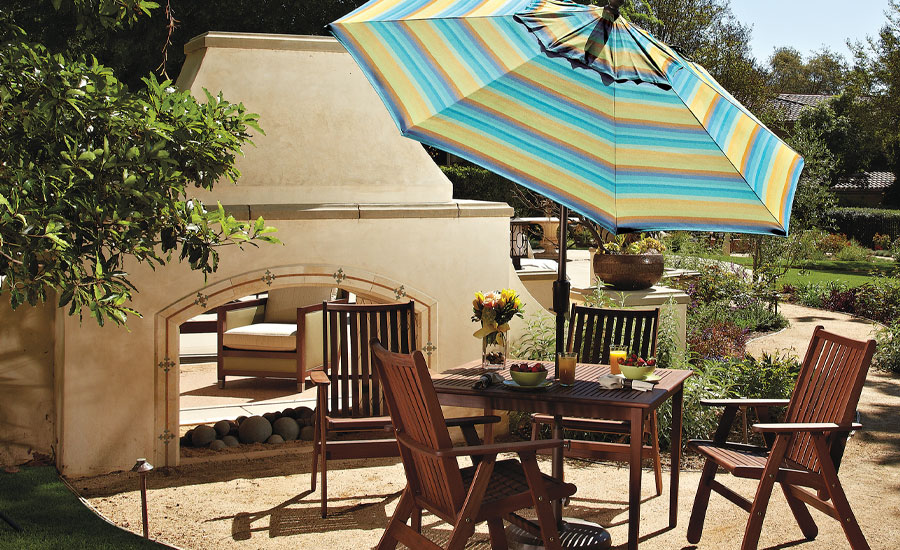
When it comes to choosing a material for your patio umbrella frame, there are two main options: wood and aluminum. Both have their own unique benefits and drawbacks, so it’s important to consider your specific needs before making a decision.
One of the main advantages of wood umbrella frames is their aesthetic appeal. They have a natural warmth and beauty that can add a touch of elegance and sophistication to your outdoor space. Additionally, wooden poles are typically thicker than their aluminum counterparts, providing added stability and durability.
However, wooden frames also have some drawbacks to consider. They are generally heavier than aluminum frames, which can make it more difficult to move the umbrella around as needed. Additionally, wood is more susceptible to weather damage, such as rot and warping, if not properly treated and maintained. Wooden frames may also require more maintenance overall, such as regular sanding and staining, to ensure their longevity.
On the other hand, aluminum umbrella frames offer many advantages over wood. They are lightweight and easy to move, making them a great option for portability. They are also highly durable and resistant to weather damage, meaning they require less maintenance than wooden frames. In some cases, aluminum frames may also provide better wind resistance, depending on the specific design and construction.
However, aluminum frames may not have the same aesthetic appeal as wooden frames, as they tend to have a more modern and industrial look. Additionally, some cheaper aluminum frames may be more prone to denting and bending over time, which can impact their stability and longevity.
Ultimately, the choice between wood and aluminum patio umbrella frames will depend on your specific needs and preferences. If you prioritize aesthetics and don’t mind a bit of maintenance, a wooden umbrella frame may be the perfect choice for your outdoor space. However, if you need something lightweight and durable that can withstand the elements with minimal upkeep, an aluminum frame may be a better fit. Whatever option you choose, be sure to look for high-quality materials and construction to ensure your patio umbrella provides long-lasting shade and shelter for your outdoor activities.
Wood Patio Umbrella

When it comes to adding some shade to your outdoor space, a wood patio umbrella may be the perfect solution. With their natural warmth and beauty, wooden umbrella frames add a touch of elegance and sophistication to any setting. However, there are some factors to consider before choosing a wood patio umbrella over other materials like aluminum or fiberglass.
First and foremost, the aesthetics of a wood patio umbrella are unmatched. The natural grain and warm colors of wood can create an inviting and cozy atmosphere that is perfect for outdoor dining or lounging. Additionally, wooden poles are typically thicker than their metal counterparts, providing added stability and durability in inclement weather conditions.
Another advantage of wood patio umbrellas is the customizable nature of the material. Wooden frames can be easily stained or painted to match your outdoor decor, giving you the freedom to create a unique look that complements your existing patio furniture. You can also choose from a wide range of canopy fabrics, colors, and sizes to create a custom look that fits your needs.
However, there are some drawbacks to consider when it comes to wood patio umbrellas. They are generally heavier than other materials like fiberglass or aluminum, making them more difficult to move around as needed. Additionally, wood is more susceptible to weather damage, such as rot and warping, if not properly treated and maintained. Regular sanding and staining are recommended to ensure the longevity of a wood patio umbrella.
Finally, wood patio umbrellas tend to be more expensive than their aluminum or fiberglass counterparts. However, if you are looking for a more high-end and elegant addition to your outdoor space, a wood patio umbrella may be the investment worth making.
In conclusion, a wood patio umbrella can be an excellent choice for those looking to create a warm and inviting outdoor space. With the durability and stability of a thicker pole, the customizability of the wood material, and the added elegance of the natural grain and colors, a wood patio umbrella is a great option for those willing to invest a little more in their outdoor decor.
Advantages of Wood Patio Umbrellas
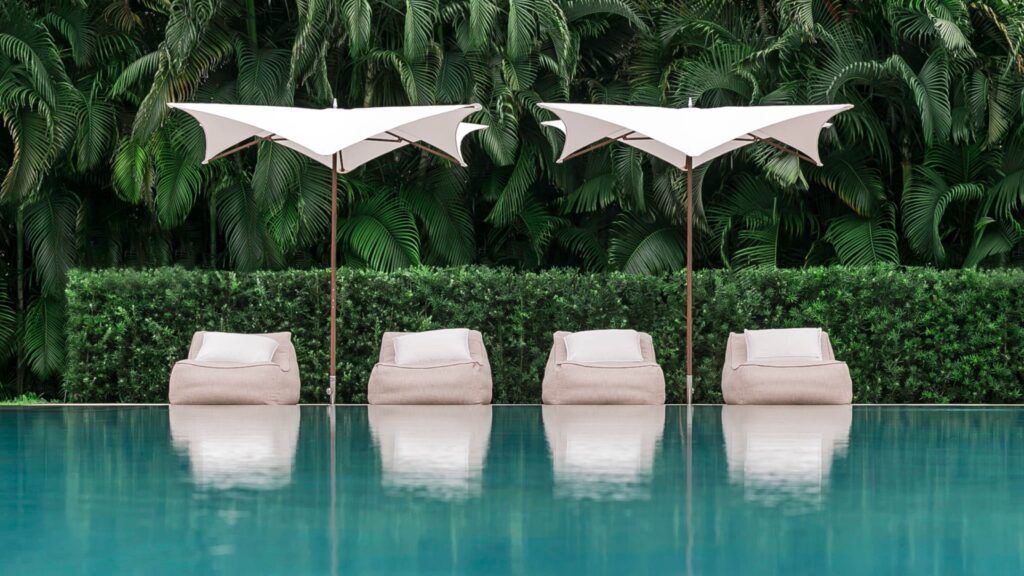
Wood patio umbrellas have long been a staple in outdoor living spaces. From their natural beauty to their durability in harsh weather conditions, there are many advantages to choosing a wood patio umbrella over other materials.
One of the biggest advantages of a wood patio umbrella is its aesthetic appeal. The natural texture and warmth of wood add a touch of rustic charm to any outdoor space. The warm hues of cedar, teak, and other types of wood evoke a welcoming atmosphere that is perfect for outdoor dining or lounging. In fact, the beauty of wood is so alluring that many people choose to use wooden patio umbrellas even indoors as part of their decor.
Aside from their visual appeal, wood patio umbrellas are also commonly known for their durability. Wooden poles are typically thicker and heavier than metal ones, providing added stability and support. This makes them more resistant to strong winds and potential wind damage. Additionally, while wood requires regular maintenance to prevent weather damage, it is also easier to repair than other materials like aluminum or fiberglass.
Another advantage of wood patio umbrellas is the customizable nature of the material. You can easily stain or paint the frame to match your existing outdoor space, giving you the freedom to create a unique look that complements your patio furniture. Furthermore, you can choose from a variety of canopy fabrics, colors, and sizes to create a custom look that fits your needs.
Lastly, wood patio umbrellas tend to be more environmentally friendly than fabric or metal alternatives. They are biodegradable and can be reused or recycled for other purposes. Additionally, if you opt for sustainably sourced or reclaimed wood, you are taking a step towards reducing the carbon footprint of your outdoor living space.
In conclusion, wood patio umbrellas offer a variety of advantages over other materials such as added durability, customization opportunities, and environmental benefits. If you are looking for an elegant and long-lasting addition to your outdoor space, a wood patio umbrella might be the perfect investment.
Disadvantages of Wood Patio Umbrellas
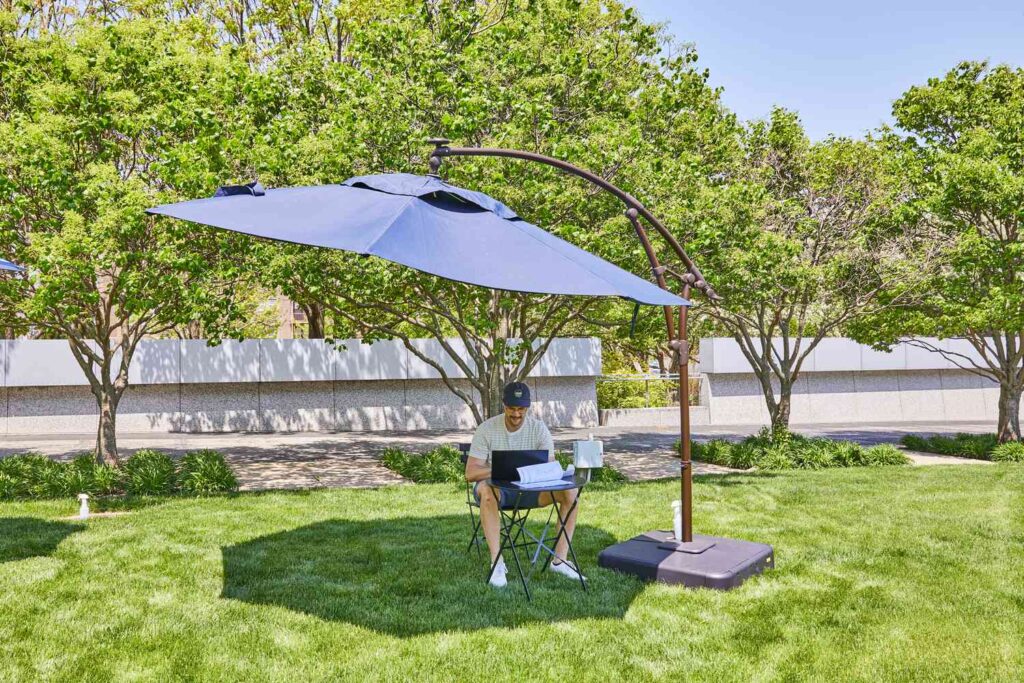
While there are many advantages to using wood patio umbrellas, there are also some disadvantages worth considering before making a purchase. These disadvantages can have an impact on how much you enjoy your outdoor living space, and they may ultimately make you reconsider going with a wooden umbrella.
One of the most significant disadvantages of wood patio umbrellas is their susceptibility to inclement weather. While wood is naturally durable and strong, it is also prone to damage from rain, wind, and other environmental factors. Exposure to the elements can cause wood to warp, crack, or rot over time, which can significantly reduce the lifespan of your umbrella. This means that you may need to replace your wooden patio umbrella sooner than you would a metal or fiberglass one, which could end up costing you more money in the long run.
Another disadvantage of wood patio umbrellas is their weight. Wooden frames tend to be heavier than metal or fiberglass frames, which can make them more challenging to move around. This can be a problem if you like to rearrange your outdoor furniture frequently or if you need to store your umbrella during the off-season. While there are lighter-weight wood options available, they may not be as durable as heavier wooden frames.
Wood patio umbrellas also require more maintenance than metal or fiberglass ones. While they are generally easier to repair, they require regular staining or painting to keep them looking their best. If you neglect this upkeep for an extended period, your wooden umbrella may start to look worn and weathered, which can detract from the overall aesthetic of your outdoor space.
Finally, wood patio umbrellas may not be the best choice for those who live in areas with high winds or strong gusts. Wooden frames are not as wind-resistant as metal or fiberglass ones, which means that they are more likely to tip over or suffer damage during severe weather conditions. While some wooden umbrellas are designed to be wind-resistant, they may not be as effective as metal or fiberglass options.
Overall, while there are many benefits to using wood patio umbrellas, there are also some significant disadvantages worth considering. Before making a purchase, weigh the pros and cons of wood umbrellas against those of metal or fiberglass options to determine which is the best fit for your outdoor living space.
Types of Woods Used for Patio Umbrellas

When it comes to choosing a patio umbrella, one of the most important factors to consider is the type of wood used in the frame. Different types of wood have varying levels of durability, strength, and resistance to the elements. Here are some of the most common types of woods used for patio umbrellas:
1. Teak: Teak is a popular choice for patio umbrellas because it is extremely durable and weather-resistant. It is also resistant to rot and insects, which makes it a low-maintenance option. Teak is also known for its natural beauty, with a rich, warm color and a smooth, fine grain.
2. Eucalyptus: Eucalyptus is a fast-growing hardwood that is often used as a sustainable alternative to other types of wood. It is strong, durable, and resistant to rot and pests. Eucalyptus also has a pleasant, light scent that can add to the ambiance of your outdoor space.
3. Cedar: Cedar is a popular choice for patio umbrella frames because it is lightweight and resistant to rot and insects. It also has a distinct, pleasant aroma that can help to repel bugs. Cedar has a natural grain pattern that ranges from straight to wavy, which can add to the visual appeal of your umbrella.
4. Cypress: Cypress is a strong, durable wood that is resistant to rot, insects, and decay. It has a distinctive grain pattern that ranges from straight to curly, which gives it a unique appearance. Cypress is also known for its light color, which can create a bright, inviting atmosphere in your outdoor space.
5. Mahogany: Mahogany is a strong hardwood that is known for its rich, red color and fine grain. It is also resistant to rot and insects, making it a durable choice for patio umbrellas. Mahogany is often used in high-end furniture and is prized for its natural beauty.
When choosing a type of wood for your patio umbrella, it is important to consider factors such as durability, maintenance, and aesthetics. Each type of wood has its own unique properties, so take the time to select the one that best suits your needs and complements your outdoor space. With proper care, a well-crafted wood patio umbrella can provide many years of shade and enjoyment.
Popular Styles of Wood Patio Umbrellas
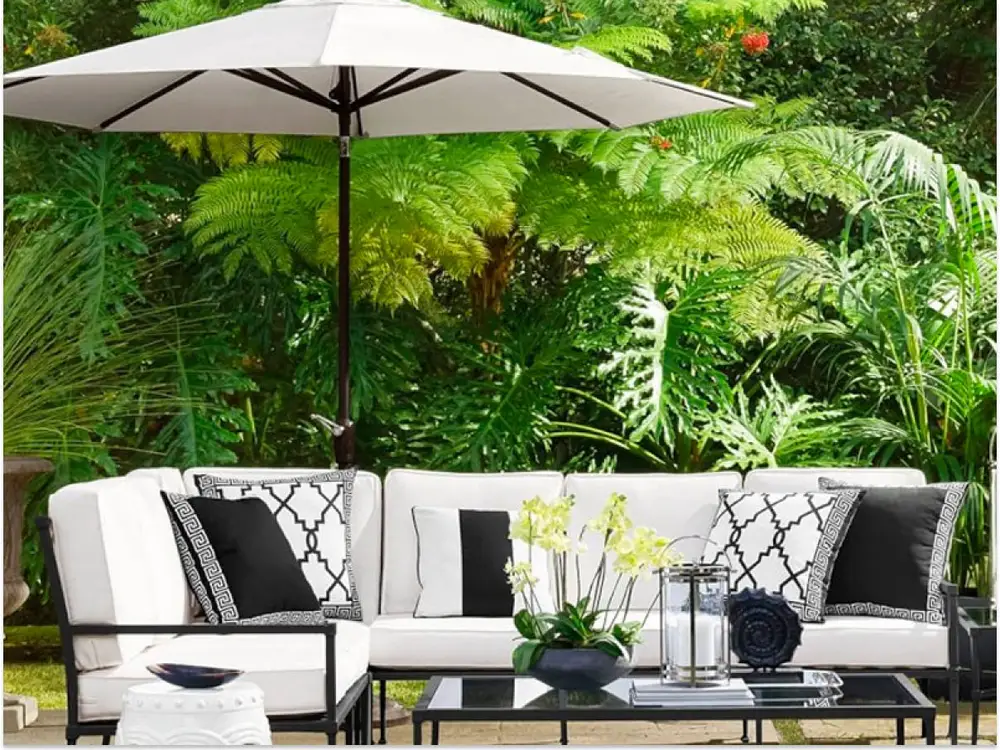
Wooden patio umbrellas are a popular choice for those who want to add a touch of elegance and natural beauty to their outdoor spaces. Besides being aesthetically pleasing, wooden umbrellas are also durable, sturdy and capable of providing much-needed shade on hot, sunny days. There are several styles of wooden patio umbrellas available, each with its unique features and benefits. In this article, we will explore some of the popular styles of wood patio umbrellas that you can consider for your outdoor space.
1. Market Umbrellas: The market umbrella is a classic style that you often see in outdoor cafes, restaurants, and markets. Market umbrellas usually have a straight pole with a thick, sturdy rib structure that can support a large canopy. The canopy of a market umbrella is typically made from durable fabric materials such as polyester and acrylic and is available in an array of colors and patterns. Market umbrellas are usually easy to set up and take down, making them a convenient option for outdoor use.
2. Cantilever Umbrellas: If you’re looking for a stylish patio umbrella that provides maximum shade coverage, then a cantilever umbrella is an excellent choice. Cantilever umbrellas feature a pole that is attached to a sturdy base, allowing the canopy to be extended outwards without the need for a central support pole. This design provides a large amount of shade coverage and allows you to place furniture underneath without worrying about the pole getting in the way.
3. Wood Frame Umbrellas: Wooden frame umbrellas are another popular style that has been around for generations. These umbrellas usually feature a wooden pole and rib structure attached to a canopy made from a variety of durable fabric materials. Wooden frames are often made from natural materials like teak, eucalyptus, and cedar, which provide a touch of elegance and natural beauty to any outdoor space.
4. Beach Umbrellas: If you live near the beach or plan to spend a lot of time in the sand, then a beach umbrella is a perfect choice for you. Beach umbrellas usually feature a pointed end that can be inserted into the sand to keep the umbrella securely in place. They are usually smaller than other types of umbrellas, making them easy to transport and store.
In conclusion, wooden patio umbrellas are a popular choice for those who want to create a classic or natural look in their outdoor spaces. From market umbrellas to cantilevered and wood frame umbrellas, there is a wide range of styles and designs available to fit your needs and preferences. Be sure to choose a high-quality wooden umbrella that is durable, sturdy, and capable of providing much-needed shade on hot, sunny days.
Aluminum Patio Umbrella
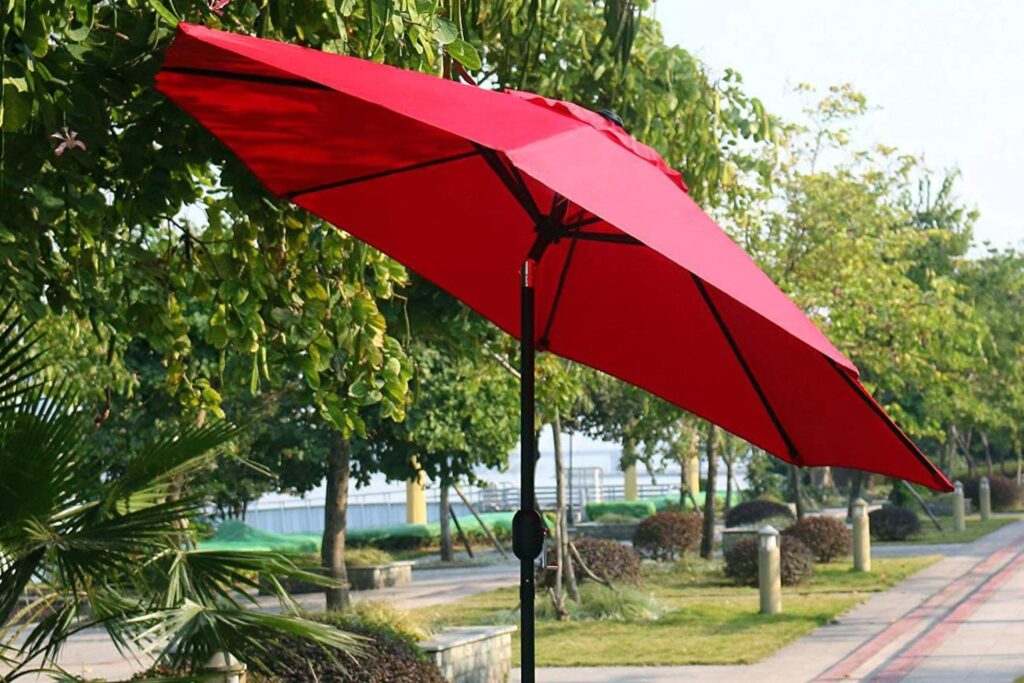
When it comes to selecting the perfect patio umbrella for your outdoor space, you may be considering many factors such as the frame material, the size of the canopy, and the color and fabric type. One option that many people choose is an aluminum patio umbrella.
Aluminum frames are known for their durability, strength, and resistance to rust and corrosion. This means that an aluminum patio umbrella can withstand the elements and keep its sleek appearance for a long time. Additionally, aluminum frames are lightweight, making them easy to move around and set up, while also providing stability and sturdiness.
Aluminum patio umbrellas are available in a wide range of sizes, from small table-top umbrellas to large cantilevered umbrellas that provide ample shade. The canopy fabric can also vary, with options ranging from polyester to acrylic fabric in a variety of colors and patterns. This allows you to choose an umbrella that matches your outdoor decor and provides the necessary sun protection.
Many aluminum patio umbrellas also feature a crank mechanism, which allows you to open and close the canopy easily, and sometimes even tilt the umbrella to adjust the angle and direction of the shade. In addition, you can purchase an umbrella base to ensure your umbrella stays securely in place, even in windy conditions.
Overall, an aluminum patio umbrella is a fantastic option for those looking for a durable, stylish, and easy-to-use shade solution for their outdoor space. With its lightweight and sturdy design, it is a practical and affordable option that can withstand the elements and provide many years of use and enjoyment.
Advantages of Aluminum Patio Umbrellas

When it comes to creating a comfortable, outdoor living space, shade is a crucial component. Patio umbrella is a great way to keep cool and enjoy the outdoors without exposing yourself to harsh UV rays and inclement weather. One of the best choices for a sturdy patio umbrella frame is aluminum. Here are some advantages of aluminum patio umbrellas:
Durability: One of the primary benefits of aluminum frames is its durability. It is resistant to rust and corrosion, ensuring that your patio umbrella can withstand the elements and maintain its beautiful appearance for years to come. It can easily endure harsh weather conditions, including rain, gusts of wind, and relentless sun. You can rest assured that your aluminum patio umbrella will hold up against the toughest outdoor conditions.
Lightweight: Aluminum is a lightweight material. This makes it very easy to move around and set up. You don’t have to be a muscleman to carry and install the umbrella. The umbrella’s lightness does not compromise its stability and sturdiness, providing a canopy that will remain in place even amidst strong winds.
Versatility: Aluminum patio umbrellas come in a wide range of styles and sizes, from small table-top umbrellas to larger cantilever umbrellas that provide ample shade. The canopy fabric can also be completely customized with a range of options available, including polyester to acrylic fabric with various colors and patterns. You can choose an umbrella that matches your outdoor decor and provides the necessary cover to enjoy your garden to the fullest.
Functionality: Aluminum patio umbrellas usually come equipped with crank mechanisms. This allows you to open and close the canopy with ease, and sometimes even tilt the umbrella to adjust the angle and direction of the shade. With a top-quality product, you won’t have to struggle with trying to fit a manual umbrella up and down. A crank mechanism will allow you to operate the umbrella effortlessly.
Affordability: Aluminum patio umbrellas are an affordable option for your outdoor furniture, making them an excellent choice for those who want to create a comfortable, stylish, yet cost-effective outdoor space. Aluminum frames are not expensive to manufacture and do not require much maintenance. Thus, these umbrellas offer an excellent cost-benefit ratio compared to other frame materials like wood or fiberglass.
In conclusion, choosing an aluminum patio umbrella can be a brilliant decision to enhance your outdoor living experience. Apart from its durability, lightness, versatility, functionality, and budget-friendly nature, aluminum patio umbrellas are also an eco-friendly choice. With all that said, it’s time to enjoy your summer days outside with the perfect patio umbrella!
Disadvantages of Aluminum Patio Umbrellas
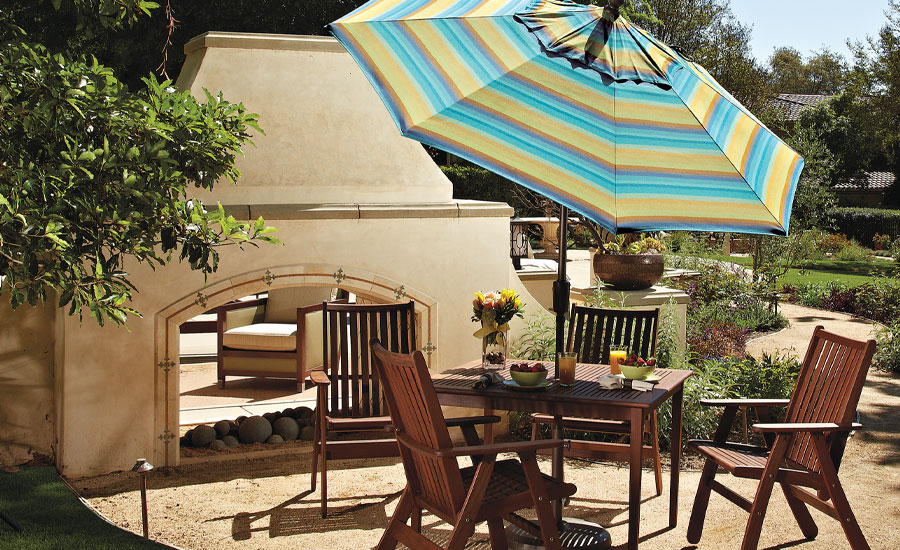
Although aluminum patio umbrellas have numerous benefits that make them a popular choice among outdoor furniture enthusiasts, there are also some drawbacks to consider before making a purchase.
One of the significant disadvantages of aluminum frames is their tendency to bend or break when exposed to high winds or heavy rain. This can lead to structural damage and possibly injury if the umbrella collapses. Therefore, it’s important to ensure the aluminum patio umbrella you choose is wind-resistant and able to withstand extreme weather conditions.
Another disadvantage of aluminum frames is their relatively shorter lifespan compared to other materials like wood or fiberglass. Although aluminum is resistant to rust and corrosion, the constant exposure to the elements can cause the metal to weaken and eventually break down over time. This can result in a reduced lifespan of the umbrella, leading to a need for frequent repairs or replacement.
Aluminum frames also have limited design options, particularly in terms of aesthetics. Although the fabric canopy can be customized to fit your outdoor decor, the frame itself typically comes in one or a few basic designs. This can limit your options when it comes to finding an umbrella that truly matches your personal style and preferences.
Lastly, aluminum frames may not be the best choice for larger patio umbrellas. Because aluminum is a relatively lightweight material, it may not provide the same level of stability and sturdiness as other materials when used for larger umbrellas. This can lead to the umbrella swaying or toppling over in high winds, potentially causing damage or injury.
In conclusion, while aluminum patio umbrellas have numerous benefits, there are also some disadvantages to consider before making a purchase. It’s important to evaluate these factors and carefully weigh the pros and cons to ensure you choose an umbrella that fits your needs and preferences while also providing the necessary protection and stability for your outdoor space.
Popular Styles of Aluminum Patio Umbrellas
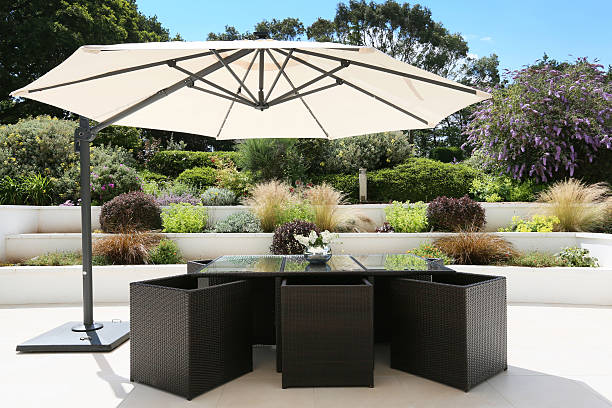
Aluminum patio umbrellas offer a versatile and stylish addition to any outdoor space. With a lightweight and durable frame material, these umbrellas are easy to set up, move around and provide ample shade from the sun. There are many styles of aluminum patio umbrellas on the market, ranging from standard to cantilevered, with various canopy and frame options.
One popular style of aluminum patio umbrella is the market umbrella. This standard umbrella style features a straight pole that can be placed through a table’s center hole or used with a standalone base. Market umbrellas are available in a range of sizes, with canopies that can be adjusted at different angles as the sun moves overhead. Many market umbrellas also feature convenient crank mechanisms, making them easy to open and close.
If you’re looking for something a little more unique, a cantilevered aluminum patio umbrella may be the perfect choice. This type of umbrella features an offset pole design, allowing for more space underneath the canopy without the obstruction of a central pole. Cantilevered umbrellas also feature adjustable canopies, making them a versatile option for any outdoor space. Many of these umbrellas also come with a convenient crank mechanism or even a remote control for easy operation.
In addition to style, aluminum patio umbrellas come in a range of colors and canopy fabrics, allowing for customization to match your outdoor decor. Popular canopy materials include solution-dyed acrylics, which are resistant to fading and stains, as well as polyester blends, which offer a more affordable option. Canopy colors run the spectrum from bright and bold to neutral and subtle.
When choosing an aluminum patio umbrella, it’s important to consider additional features such as wind resistance and umbrella base compatibility. Some aluminum frames are engineered to withstand strong winds, while others may require a heavier base or additional support for stability. It’s always best to check the manufacturer’s recommendations for your specific model to ensure optimal use and safety.
In summary, aluminum patio umbrellas offer a wide range of styles, colors, and features to fit any outdoor space or design preference. Whether you opt for a classic market umbrella or a modern cantilevered design, an aluminum patio umbrella can add both function and style to your outdoor oasis.
Factors to Consider When Choosing Between a Wood or an Aluminum Patio Umbrella
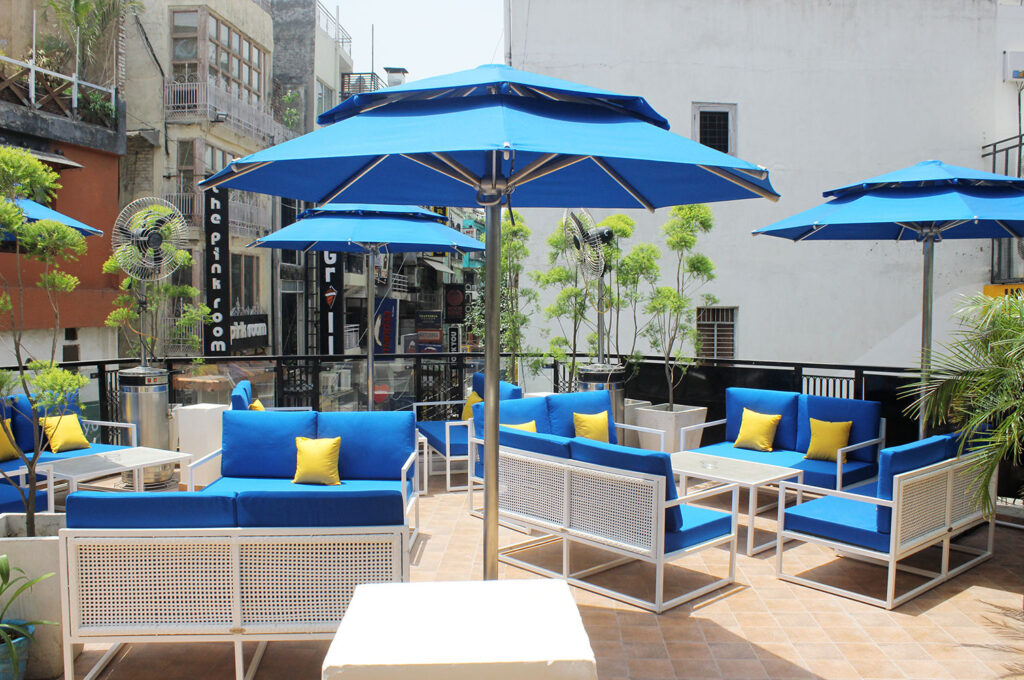
Choosing the right patio umbrella for your outdoor space can be quite a daunting task, especially with the wide range of options available, including wood and aluminum umbrellas. While both materials have their unique advantages and disadvantages, there are certain factors you should consider before making your final decision on which one to choose.
Frame Material
One of the most critical factors to consider is the frame material of the umbrella. Wood frames are traditional and give a classic, natural look to outdoor spaces. They often come in teak, bamboo, and eucalyptus, and are known for their durability and sturdiness. However, wood umbrellas require more maintenance because they are prone to warping, cracking, and fading when exposed to harsh weather conditions.
On the other hand, aluminum frames are trendy, lightweight, and resistant to rust and corrosion. Some aluminum models feature a powder-coating that can add extra protection against inclement weather. However, aluminum frames may not give the same natural look and feel to an outdoor space compared to wood frames, even though some models mimic the look of wood.
Size
Another critical factor to consider when choosing between wood and aluminum patio umbrellas is size. Consider the size of your outdoor dining table, patio furniture, or the area you want to shade. It’s essential to choose an umbrella canopy that’s large enough to cover your space but not too bulky or heavy for your patio table or base. Aluminum frames tend to be much lighter, making them ideal for larger umbrellas with broad canopies, while wood is usually preferred for smaller, bistro-style umbrellas.
Maintenance
As previously mentioned, wood patio umbrellas tend to require more maintenance than aluminum models. Wood frames do not tolerate exposure to harsh weather conditions and require frequent staining, sealing, or painting. In contrast, aluminum frames require little to no maintenance and can easily be wiped clean with a cloth and mild soap and water.
Durability
It’s important to consider the durability of your patio umbrella, whether it’s wood or aluminum. Wood frames are susceptible to rotting, cracking, or warping when exposed to direct sunlight, rain, and wind, while aluminum frames are resistant to these elements. When choosing an umbrella, look for wind-resistant features like double venting or fiberglass ribs that can withstand strong winds. Similarly, consider the type of canopy fabric used, opting for materials like acrylic or polyester blends that are durable and resistant to fading and stains.
In conclusion, choosing between wood and aluminum patio umbrellas ultimately comes down to personal preference and the factors discussed above, such as frame material, size, maintenance, and durability. Regardless of your choice, a good patio umbrella can enhance your outdoor space and protect you from the sun’s harmful rays while adding style and functionality to your outdoor furniture.
Canopy Size and Shape
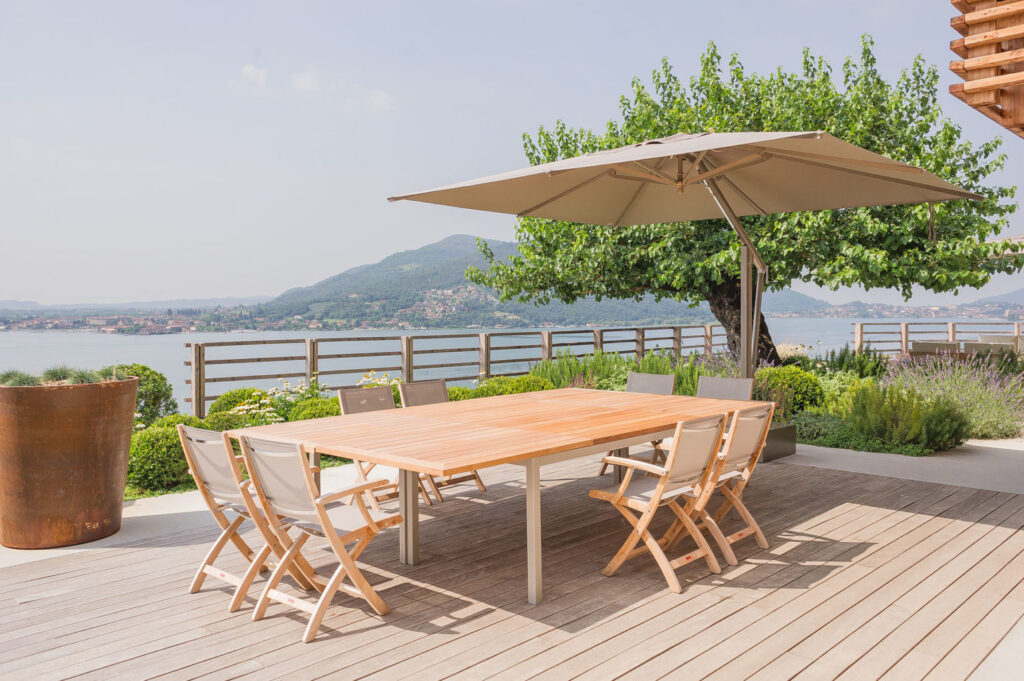
When shopping for a patio umbrella, the size and shape of the canopy are essential factors to consider. Not only do they affect how much shade and coverage you get, but they can also impact the overall aesthetics and style of your outdoor space.
Size Matters
The size of the umbrella canopy refers to its diameter or span, usually measured in feet or inches. The bigger the canopy, the more shade and coverage you get, but it also means a bigger footprint on your patio or deck. You’ll want to choose a size that’s proportional to your outdoor furniture and space. For example, if you have a large dining table or seating area, you may need an umbrella with a 9- or 10-foot diameter. A smaller bistro table may only require a 6-foot umbrella.
Keep in mind that the size and weight of the umbrella also affect its stability and wind resistance. If you live in a windy area, it’s best to choose a heavier and sturdier umbrella that won’t tip over easily. You can also look for umbrellas with wind-resistant features such as vented canopies, flexible fiberglass ribs, and sturdy aluminum poles.
Shape Options
When it comes to umbrella shapes, there are several options to choose from, including round, square, rectangular, and oval. Round umbrellas are the most traditional and common shape and work well for most outdoor spaces. Square and rectangular umbrellas may be better suited for long and narrow areas or modern and contemporary settings.
Oval-shaped umbrellas are a newer trend and offer a unique and stylish look that stands out from the crowd. They’re also ideal for shading longer tables or seating arrangements. However, keep in mind that oval umbrellas may be more challenging to find and cost more than traditional round or square umbrellas.
In addition to the shape and size of the canopy, you’ll also want to consider the fabric and color options. Choose a fabric that’s durable and weather-resistant, such as acrylic or polyester blends. Darker colors tend to provide more shade and protection from UV rays, while lighter colors may show stains and dirt more easily.
In summary, canopy size and shape are crucial factors to consider when choosing a patio umbrella. Whether you opt for a traditional round umbrella or a modern oval-shaped one, make sure it’s the right size for your space and furniture and offers the features and materials that meet your needs and preferences.
Type of Frame Material
When it comes to choosing the perfect patio umbrella for your outdoor space, there are a few key decisions to make. One of the most important factors to consider is the material of the frame. The frame material not only affects the appearance of the umbrella but also its durability, weight, and overall performance. Here are some common types of frame materials for outdoor patio umbrellas:
Aluminum Frames
Aluminum is a popular choice for patio umbrella frames as it is lightweight, durable, and resistant to rust and corrosion. It’s also easy to clean and maintain, making it a great option for busy homeowners. Aluminum frames come in various finishes, including bronze, silver, and black, to match your outdoor furniture and decor.
Wood Frames
Wooden frames are a classic option for patio umbrellas and are often used to create a natural and rustic look. Wood frames are durable and sturdy, but they require more maintenance than aluminum frames. They should be treated and sealed regularly to prevent damage from insects, moisture, and inclement weather. Wooden frames come in a range of finishes, from light and natural to dark and stained.
Fiberglass Frames
Fiberglass is a newer material for patio umbrella frames and is becoming increasingly popular thanks to its many benefits. Fiberglass frames are lightweight, strong, and flexible, making them ideal for areas with strong winds. They also offer a sleek and modern appearance and can be finished with various textures and colors.
Steel Frames
Steel frames are a heavy-duty option for patio umbrellas and are often used for commercial settings or areas with severe weather. Steel frames are durable and can withstand heavy wind gusts and rain, but they are also heavy and require more maintenance than other materials.
In conclusion, the frame material of a patio umbrella is an essential factor to consider, as it affects its appearance, durability, weight, and performance. Aluminum frames are lightweight and low-maintenance, wood frames offer a classic and natural look, fiberglass frames provide flexibility and modern style, and steel frames are heavy-duty and sturdy. Choose the frame material that best suits your outdoor space and needs.
Weight and Stability
When it comes to choosing the perfect patio umbrella, weight and stability are important factors to consider. After all, the last thing you want is for your umbrella to topple over during a gust of wind or a sudden rainstorm.
Aluminum frames are often the go-to choice for homeowners looking for a lightweight option. They are easy to move around and set up, and can be adjusted easily as the sun moves across the sky. However, while aluminum frames are durable and resistant to rust and corrosion, they may not be the most stable option for areas with strong winds.
Wood frames, on the other hand, are generally heavier and more stable than their aluminum counterparts. They provide a natural and rustic look that many homeowners love, and can complement any outdoor furniture and decor. However, wooden frames require more maintenance than aluminum frames, and may not be the best choice for areas with frequent rain or snow.
Fiberglass frames offer the best of both worlds. They are lightweight and flexible like aluminum frames, but also offer the stability and durability of wooden frames. In fact, fiberglass frames are becoming increasingly popular thanks to their ability to withstand even the strongest winds.
Steel frames are the heaviest and most durable option on the market. While they may be difficult to move and adjust, they are perfect for commercial settings or areas with severe weather conditions. Steel frames can withstand heavy wind gusts and rain, providing strong protection against the elements.
When choosing the weight and stability of your patio umbrella, it’s important to consider your specific needs and budget. A lighter, aluminum frame may be suitable for a backyard patio or garden, while a heavier, steel frame may be necessary for a commercial setting or high-wind area. Regardless of your choice, make sure to choose a high-quality frame material that will provide you with the durability and protection you need for years to come.

